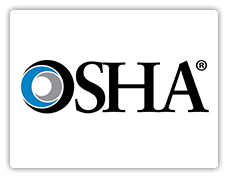 OSHA started a new initiative this year: if the OSHA 300A data an employer submits to the Injury Tracking Application (ITA) shows the rates are above their industry averages, then that employer will receive an email. The email is informational only and obligates an employer to do nothing. As with every employer, regardless of their rates, OSHA encourages frequent review of safety and health efforts.
OSHA started a new initiative this year: if the OSHA 300A data an employer submits to the Injury Tracking Application (ITA) shows the rates are above their industry averages, then that employer will receive an email. The email is informational only and obligates an employer to do nothing. As with every employer, regardless of their rates, OSHA encourages frequent review of safety and health efforts.
As always, we are here to answer any of your OSHA questions - please reach out to your KnowledgeBroker or view one of our OSHA webinars.
For your information, below is an excerpt of the email:
Dear Employer:
OSHA recognizes that the DART rate does not necessarily indicate a lack of interest in workplace safety and health. If you are one of the many employers who would welcome help from experts in workplace safety and health, OSHA has many compliance assistance resources, several of which are at no cost and confidential.
If you are a small employer with fewer than 250 workers on-site and no more than 500 workers corporate-wide, OSHA’s On-Site Consultation Program is available to you. This program is administered by state governments completely separate from OSHA’s enforcement program. The program assists employers to identify and eliminate or control hazards effectively and economically. More information on this program, including contact information for the local office in your state is available at https://www.osha.gov/consultation.
OSHA has resources to assist a company to develop and implement a safety and health program. Such a program to find and fix workplace hazards before they cause injury or illness can proactively reduce injuries, illnesses, and fatalities. Not only do employers experience dramatic decreases in workplace injuries, but they also often report a transformed workplace that can lead to higher productivity and quality, reduced turnover, reduced costs, and greater employee satisfaction. If you use the On-Site Consultation Program, the state consultant can help you develop an injury and illness prevention program. More information can be found on the OSHA webpage at www.osha.gov.
Other avenues to address this issue include hiring an outside safety and health consultant, working with your insurance carrier, or contacting your state’s workers’ compensation agency for advice to address a high DART rate. In addition, engaging your workers to identify hazards and find solutions is a proactive method to resolving safety and health hazards.
Thank you for your attention to this matter.
Sincerely,
Occupational Safety and Health Administration
 Online retailer Amazon recently announced that you can now use your flexible spending account (FSA) or health savings accounts (HSA) to purchase eligible medical products on its site. Amazon’s FSA and HSA stores enable you to add your respective health payment card to the site and shop for your eligible products as you would shop for any other item.
Online retailer Amazon recently announced that you can now use your flexible spending account (FSA) or health savings accounts (HSA) to purchase eligible medical products on its site. Amazon’s FSA and HSA stores enable you to add your respective health payment card to the site and shop for your eligible products as you would shop for any other item.
 Did you know that $4.5 billion in Affordable Care Act (ACA) employer mandate penalties were assessed by the IRS for the first assessment year alone (2015)? It is expected that by 2026, over $228 billion in penalties will have been assessed. This summer, the IRS began sending Letters 226-J for proposed 2017 ACA employer mandate penalties. Additionally, the IRS is increasing efforts to identify potential non-filers via Letter 5699.
Did you know that $4.5 billion in Affordable Care Act (ACA) employer mandate penalties were assessed by the IRS for the first assessment year alone (2015)? It is expected that by 2026, over $228 billion in penalties will have been assessed. This summer, the IRS began sending Letters 226-J for proposed 2017 ACA employer mandate penalties. Additionally, the IRS is increasing efforts to identify potential non-filers via Letter 5699. An employee’s mental health encompasses how they think, feel and act. It also includes their emotions and social well-being. While mental health does include mental illness, these two are not interchangeable.
An employee’s mental health encompasses how they think, feel and act. It also includes their emotions and social well-being. While mental health does include mental illness, these two are not interchangeable.

 OSHA started a new initiative this year: if the OSHA 300A data an employer submits to the Injury Tracking Application (ITA) shows the rates are above their industry averages, then that employer will receive an email. The email is informational only and obligates an employer to do nothing. As with every employer, regardless of their rates, OSHA encourages frequent review of safety and health efforts.
OSHA started a new initiative this year: if the OSHA 300A data an employer submits to the Injury Tracking Application (ITA) shows the rates are above their industry averages, then that employer will receive an email. The email is informational only and obligates an employer to do nothing. As with every employer, regardless of their rates, OSHA encourages frequent review of safety and health efforts.
 On July 23, 2019, the Internal Revenue Service (IRS) issued Revenue Procedure 2019-29 to index the contribution percentages in 2020 for purposes of determining affordability of an employer’s plan under the Affordable Care Act (ACA). The ACA’s employer shared responsibility or play or pay rules require ALEs (Applicable Large Employers) to offer affordable, minimum value health coverage to their full-time employees (and dependents) or pay a penalty. ALEs are those employers with an average of 50 or more full-time and full-time equivalent employees during the preceding calendar year.
On July 23, 2019, the Internal Revenue Service (IRS) issued Revenue Procedure 2019-29 to index the contribution percentages in 2020 for purposes of determining affordability of an employer’s plan under the Affordable Care Act (ACA). The ACA’s employer shared responsibility or play or pay rules require ALEs (Applicable Large Employers) to offer affordable, minimum value health coverage to their full-time employees (and dependents) or pay a penalty. ALEs are those employers with an average of 50 or more full-time and full-time equivalent employees during the preceding calendar year.
 On Wednesday, July 17th, the Internal Revenue Service added care for a range of chronic conditions to the list of preventive care benefits that
On Wednesday, July 17th, the Internal Revenue Service added care for a range of chronic conditions to the list of preventive care benefits that 